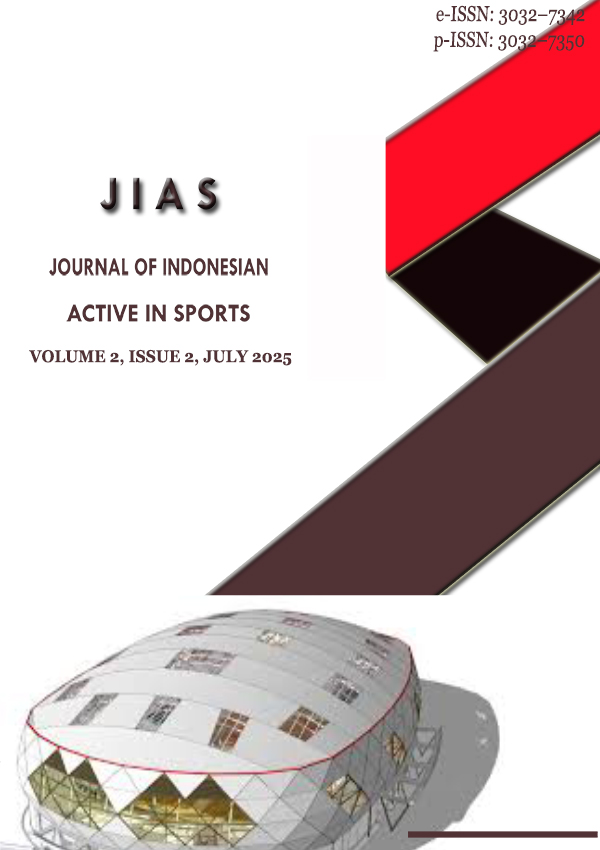Impact of Resistance Band Training on Arm Muscle Power in 11-12-Year-Old Male Freestyle Swimmers: A 2024 Study at Aquatic Swimming Club Medan
DOI:
https://doi.org/10.24114/jias.v2i2.64503Abstrak
This study investigates the effect of resistance band exercise variations on arm muscle power in 50-meter freestyle swimmers aged 11-12 years at the Aquatic Swimming Club Medan in 2024. Swimming, particularly the freestyle stroke, requires significant arm strength for optimal performance, and many young athletes struggle to meet competition standards due to insufficient muscle power. The research, conducted from July 25 to September 17, 2024, employed an experimental design with a one-group pretest-posttest structure. Eight athletes were selected using purposive sampling based on specific criteria, including proficiency in freestyle swimming and active club membership. The study utilized the Two-Hand Medicine Ball Put test to measure arm muscle power. Statistical analysis, specifically a paired t-test, was performed on the pre-test and post-test data. The results showed a significant improvement in arm muscle power, with the pre-test mean score of 24.96 increasing to 25.47 after six weeks of resistance band training. The calculated t-value of 9.643 was greater than the critical t-value of 1.894 at a 0.05 significance level, indicating that the observed improvement was statistically significant. This study concludes that resistance band training effectively enhances arm muscle power in young swimmers, which is critical for improving their performance in competitive swimming. The findings suggest that such training can be a beneficial addition to swimming programs, especially for athletes in the 11-12 age group. Future research could explore the long-term effects of resistance band training on swimming performance, investigate the impact of combined training methods, and assess the sustainability of these training gains in larger, more diverse swimmer populations.Referensi
Harsono. (1998). Coaching dan Aspek-aspek Psikologis dalam Coaching. Jakarta: Proyek pengembangan Lembaga Pendidikan Tenaga Kependidikan.
Hartono, F. V., Sukur, A., Miftakhudin, H., & Marhadi, M. (2024). Effectiveness of resistance band swimming training on muscle strength in swimmers with physical disabilities in the 50-meter freestyle. Jurnal SPORTIF: Jurnal Penelitian Pembelajaran, 10(3), 452-467.
Hudayhana, N. L. (2014). Pengaruh Modifikasi Latihan Renang Menggunakan Ban Terhadap Kecepatan Renang 50 Meter Gaya Bebas. Jurnal Kesehatan Olahraga, 2(2), 23-36.
Ismaryati. (2008). Tes dan Pengukuran Olahraga. Surakarta: UNS Press.
Lumintuarso, R. (2013). Pembinaan Multilateral Bagi Atlet Pemula. Yogyakarta: UNY Press.
Mulyana, B. (2013). Hubungan Konsep Diri, Komitmen, dan Motivasi Berprestasi dengan Prestasi Renang Gaya Bebas. Jurnal Cakrawala Pendidikan, 3(3), 488-498.
Ratno, P., & Simanjuntak, A. H. (2022). Pengaruh Latihan Latihan Resistance Band Terhadap Kecepatan Tungkai Atas Renang 50 Meter Gaya Bebas Pada Atlet 10-15 Tahun Aquatic Swimming Club Medan. Jurnal Ilmu Keolahragaan, 20(1), 219-224.
Sembiring, J. B. (2021). Pengaruh Variasi Latihan Resistance Band Terhadap Kekuatan Otot Lengan Pada Atlet Renang Putra Usia 12-13 Tahun Sailfish Swimming Club Medan Tahun 2021. (Undergraduate Degree Thesis (Undergraduate)), Universitas Negeri Medan, Medan. Retrieved from https://digilib.unimed.ac.id/id/eprint/48008 (2022-PKO-007 / 797.21 Juv p)
Sudjana. (2002). Metode Statistika. Bandung: Tarsito.
Sudjana. (2005). Metode Statistika (6 ed.). Bandung: Tarsito.
Van Hooren, B., Aagaard, P., & Blazevich, A. J. (2024). Optimizing Resistance Training for Sprint and Endurance Athletes: Balancing Positive and Negative Adaptations. Sports Medicine, 54(12), 3019-3050. doi:https://doi.org/10.1007/s40279-024-02110-4
Unduhan
Diterbitkan
Cara Mengutip
Terbitan
Bagian
Lisensi
Hak Cipta (c) 2025 Bakti Fridolin Sihite & Haris Kurniawan

Artikel ini berlisensiCreative Commons Attribution-ShareAlike 4.0 International License.












